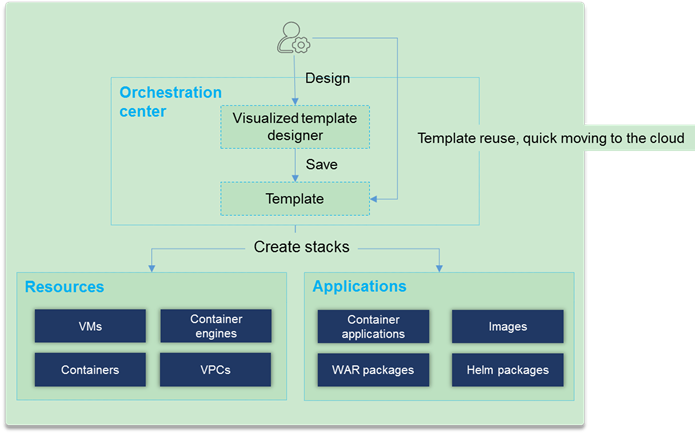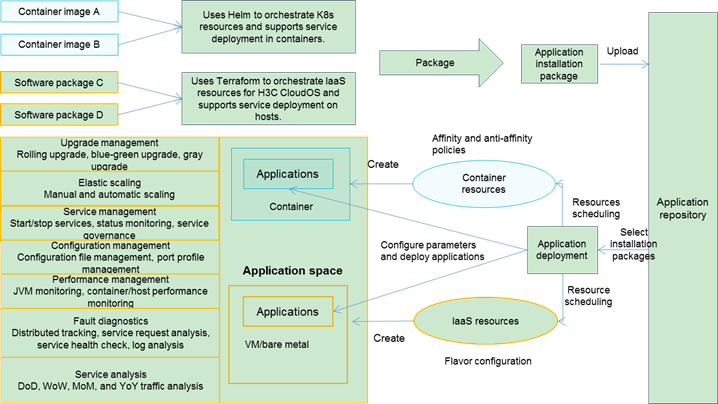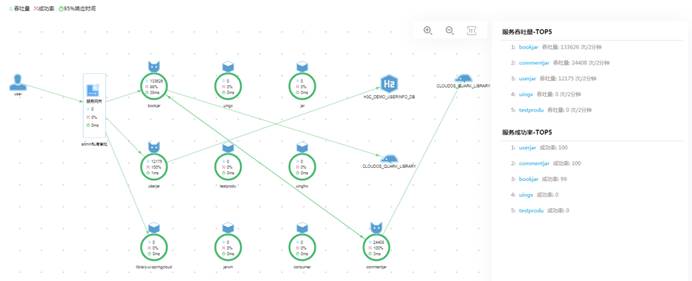- Products and Solutions
- Industry Solutions
- Services
- Support
- Training & Certification
- Partners
- About Us
- Contact Sales
- Become a Partner
-
 Login
Login
Country / Region
H3C Container Cloud
Designed from many years of experience of H3C in cloud and container management, H3C container cloud provides highly available, scalable, and secure enterprise-level container management with robust performance. It not only provides enhanced O&M capability for containers, enables fault self-healing, and ensures stability of the base environment, but also upgrades the container network and optimizes storage plug-ins. It delivers systematic DevOps capability and dual-mode microservices governance capability. With the idea of born in the cloud and growing in the cloud, it offers lifecycle management of applications to drive business innovations.
The following contents are complex, and it is recommended to browse on PC.

Enter c.h3c.com.cn on the PC browser and operate according to the page to synchronize to the PC and continue browsing.
Continue by mobile
Figure 1 H3C container cloud architecture

Rich application cases, proved stability and reliability—Widely applied in the government, finance, medical treatment, and transport verticals, H3C container cloud enables smooth operation of varieties of business systems. These successful application cases fully demonstrate its high availability at enterprise level.
High availability and scalability—Kubernetes is employed from the initial OpenStack cloud platform to the current container cloud platform, which ensures high availability of the management system and allows smooth upgrade and scaling of the CloudOS management platform, and meets the deployment requirements of cloud platforms of different scales.
Full lifecycle management of applications—Manages applications throughout their entire lifecycle, from image management, delivery management, template management, to elastic scaling management, upgrade and release management, and O&M management.
Visualized service orchestration, fast deployment of complex applications—Orchestrates complex resources and application deployments by using templates, which simplifies operations and enables moving to the cloud at one click.
Enhanced container O&M capability, improving stability of container application services—Developed out of years of experiences in implementing projects and running containers and microservices on management platforms, H3C container cloud can detect and repair dozens of system issues automatically to ensure stability of the base environment.
Upgraded container network, enhancing network security and efficiency—Support for security policies and multi-tenancy makes mutual access across networks safe and controllable. Applications running on containers can access databases running on VMs in high efficiency.
Advanced container storage, improving storage flexibility—H3C container cloud optimizes static and dynamic provisioning of storage volumes to improve storage flexibility. Compatible with multiple storage protocols (including iSCSI, FC, NFS, RBD), H3C container cloud supports different types and specifications of storage backends.
All-scenario microservices governance capabilities—Seamless convergence of service governance capability and container service capability enables invasive/non-invasive service governance capability for different types of applications and addresses different requirements of customers for moving services to the cloud and running applications on the cloud.
Application diagnostics, making applications run more stably—Employing robust analytics capabilities such as distributed tracing across business systems, evaluation of Apdex metrics, analysis on topologic relations of services, application access density, and application calling, H3C container cloud can quickly identify business system exceptions and simplify O&M complexity.
Systematic DevOps capabilities, streamlining and smoothing the development process—With an underlying open-source toolchain, H3C container cloud provides continuous integration, testing, and deployment capabilities. A variety of full/half-automated pipeline templates that are flexible and easy to use simplifies configuration and improves service development efficiency.
Multi-cluster management—Seamless integration with IaaS allows provisioning of node resources for K8s clusters, enabling KaaS and incorporation of multiple existing K8s clusters simultaneously.
High availability of the image repository—H3C container cloud provides an image repository that supports multi-tenancy to deliver image management and security scanning for uploaded images. K8s ensures high availability of the image repository. Shared storage ensures high availability of images.
Multi-tenancy model—Support for cluster resource multi-tenancy from individual K8s resources to image management allows complete match of H3C container cloud for customer's organizational structure and enables O&M flexibility for customers.
Enhanced network plug-ins—Enhanced network plug-ins enable communication between VMs, bare metals, and containers at Layer 2 and seamless interoperation of H3C container cloud with traditional IaaS resources. The plug-ins can keep containers' IP addresses unchanged in case of failovers and ensure mutual access by using IPs.
Service orchestration—On H3C container cloud, you can drag and drop software packages, applications, application groups, operating environments, microservices engines as needed in a visualized topology and connect related components with lines, to complete logical planning of service deployment. This process is simple and easy, enabling moving to the cloud at one click.
Dual-mode service governance capability—H3C container cloud provides visualized circuit breaking, rate limit, distributed tracing capabilities, supports unified deployment, management, and governance of multiple microservices frameworks such as Istio, SpringCloud, and Dubbo.
Elastic scaling—H3C container cloud allows for second-level elastic scaling based on various monitoring data. Manual and periodic scaling is also supported.
Visualized DevOps pipelines—H3C container cloud provides visualized DevOps pipeline orchestration through the entire DevOps process from the source code warehouse to application release. In addition, varieties of pipeline templates are provided, friendly for users especially at their first-time operation.
Enterprise-class stability—H3C container cloud ensures stability of the base environment with an automated fault detection, alarming, and repair mechanism, reserves resources for basic services that will not be preempted by other services to guarantee operation of basic services through QoS, and optimizes etcd codes to reduce I/O performance sensitivity.
Collaboration with other products—Seamless integration with H3C IaaS, big data, various middleware and other products allows H3C container cloud to deliver a complete cloud platform solution.
Service orchestration
Microservicing will lead to a huge increase in the number of service components. On H3C container cloud, you can drag and drop software packages, applications, application groups, operating environments, and microservices engines as needed in a visualized topology and connect related components with lines, to complete logical planning of service deployment. This process is simple and easy, enabling moving to the cloud at one click.
Benefits
Orchestration by using templates—Orchestrates complex resource configuration and application deployment configuration by using templates.
Hybrid orchestration—Supports management and orchestration of multiple types of resources and applications including VMs, container engines (K8s), containers, and applications.
One-click deployment—Applications are deployed using templates and onboard at second level, releasing developers from repeated workloads.
Figure 1 Service orchestration

Application lifecycle management
H3C container cloud uses pipelines to automate application delivery process, including building source codes, building and releasing images, and managing applications, enabling one-stop application deployment, release, and management.
Benefits
Application lifecycle management offers the following benefits:
Convenient pipeline customization
Provides abundant pipeline templates, allows customization of pipeline processes and jobs as needed, automates execution of the pipelines, provides visibility into the execution process, and displays results in logs.
Storing installation package in multiple formats in the application repository
Provides version management, installation package index, installation package isolation for installation packages in Helm format and Terraform format.
Lifecycle management
Offers application package-centric simplified management and supports load balancing, elastic scaling, configuration management, topology, continuous delivery, and service discovery for applications.
Figure 2 Application lifecycle management

Service governance
H3C container cloud can provide out-of-box service governance capability to implement gray release, traffic governance, and traffic monitoring without user perception.
Benefits
One-click deployment.
Control of service flows intelligently.
Automates dynamic intelligent routing and elastic traffic management without any modifications on applications.
Panoramic service topology and distributed tracing.
Application service grid provides real-time monitoring and operation diagnostics for traffic topologies and call chains based non-invasive monitoring data collection, to construct a panoramic service operation view.
Figure 3 Service governance

Professional Kubernetes pre-sales consulting services
Describes H3C's Kubernetes (K8s) service delivery history, implementations of full-range Kubernetes functionalities, Kubernetes use cases across all verticals and fields, and advantages in Kubernetes platform building.
Kubernetes demo services
Provides online and offline Kubernetes demo to help users have a comprehensive and profound understanding of all Kubernetes functionalities. During the demonstration, all kinds of questions from users are answered, including Kubernetes fundamentals and usage issues. The Kubernetes environment is also built for users to experience the functionalities of the Kubernetes cluster and how smoothly and stably the applications run on the Kubernetes cluster.
Tailored Kubernetes services
Plans and tailors the Kubernetes platform configuration, including the numbers of master nodes, worker nodes, and hosting servers as well as the CPU, memory, and disk sizes for each node and server to best suit the customer's business needs and system specifications including the user range, number of users, maximum concurrency, and resource consumptions. It also offers personalized service customization to address different customer needs, to enhance application operating efficiency, and to drive business innovations.
Highly available Kubernetes operations services
Provides Kubernetes infrastructure basic services, such as node isolation and recovery, node expansion, dynamic Pod scaling, label use and management, application rolling upgrade, and Kubernetes cluster high availability solution.
Provides Kubernetes security services, including health check for container applications, security isolation mechanism, container image scanning, network security planning, master node self-healing, and automatic inspection and repair of dozens of system issues.
Provide Kubernetes all-around monitoring services and uses open-source projects such as Prometheus to monitor usage of resources such as CPUs, memories, and nodes in the Kubernetes cluster.
Kubernetes basic knowledge and usage training
Basic knowledge
Kubernetes development history, overall framework, and full-stack ecosystem.
Kubernetes key principles, such as scheduling and control principles, operation mechanism analysis, security mechanisms, and networking principles.
Actual deployment modes of Kubernetes, such as in the same cluster with CloudOS or in a separate cluster.
Operation guide
Provides an all-inclusive user operation manual with clear division of Kubernetes functionalities. The procedures contained in each function are concise and clear, with pictures and texts to help users get started quickly.
Course catalog
Kubernetes basics
-Kubernetes Overview
-Kubernetes Docker Basics
-Kubernetes Concepts
-Kubernetes Resource Lists
-Kubernetes Pod Controllers
-Kubernetes Service Discovery
-Kubernetes Resource Scheduling
-Getting Started with Kubernetes Service Publishing
-Kubernetes Configuration Management
Kubernetes advanced
-Getting Started with Kubernetes Persistent Storage
-Kubernetes Advanced Scheduling Tasks/Taints and Tolerances/Affinity
-Kubernetes Advanced Scheduling Admission Control
-Kubernetes Fine-Grained Permission Control
Kubernetes expert
-Kubernetes Cloud Native Storage and Advanced Storage
-Kubernetes Middleware Containerization and HELM
-Kubernetes AIOps
-Kubernetes Cluster Upgrade
-Kubernetes Security Mechanism
-Kubernetes CRD
-Kubernetes Network Mode
-Kubernetes Network Policy
-Kubernetes Grid Service
Kubernetes practices:
-Kubernetes Cluster Building Practices
-Kubernetes Container Management Practices
-Kubernetes Container Image Orchestration Practices
-Kubernetes Controller Practices
-Kubernetes Service Practices
-Kubernetes Storage Volume Practices
Resource Center
- Cloud & AI
- InterConnect
- Intelligent Computing
- Intelligent Storage
- Security
- SMB Products
- Intelligent Terminal Products
- Product Support Services
- Technical Service Solutions
Product Support Services
Technical Service Solutions
- Resource Center
- Policy
- Online Help
- Technical Blogs
Resource Center
Policy
Online Help
- Become A Partner
- Partner Policy & Program
- Global Learning
- Partner Sales Resources
- Partner Business Management
- Service Business
Global Learning
- Profile
- News & Events
- Online Exhibition Center
- Contact Us

